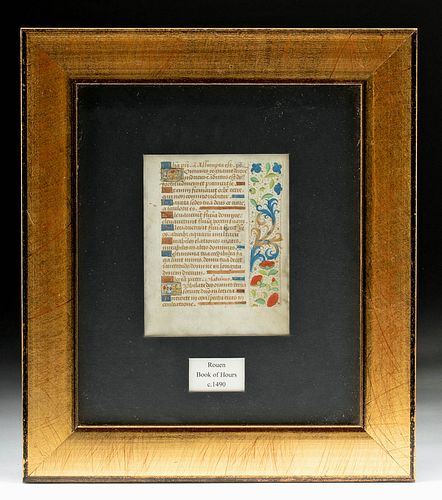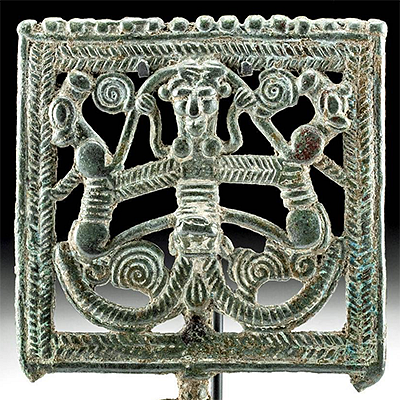15th C. French Vellum Illuminated Book of Hours Page
Lot 128
About Seller
Artemis Fine Arts
686 S Taylor Ave, Ste 106
Louisville, CO 80027
United States
Selling antiquities, ancient and ethnographic art online since 1993, Artemis Gallery specializes in Classical Antiquities (Egyptian, Greek, Roman, Near Eastern), Asian, Pre-Columbian, African / Tribal / Oceanographic art. Our extensive inventory includes pottery, stone, metal, wood, glass and textil...Read more
Categories
Estimate:
$800 - $1,200
Absentee vs Live bid
Two ways to bid:
- Leave a max absentee bid and the platform will bid on your behalf up to your maximum bid during the live auction.
- Bid live during the auction and your bids will be submitted real-time to the auctioneer.
Bid Increments
| Price | Bid Increment |
|---|---|
| $0 | $25 |
| $300 | $50 |
| $1,000 | $100 |
| $2,000 | $250 |
| $5,000 | $500 |
| $10,000 | $1,000 |
| $20,000 | $2,500 |
| $50,000 | $5,000 |
| $100,000 | $10,000 |
| $200,000 | $20,000 |
About Auction
By Artemis Fine Arts
Nov 5, 2020
Set Reminder
2020-11-05 10:00:00
2020-11-05 10:00:00
America/New_York
Bidsquare
Bidsquare : Ancient & Ethnographic From Around the World
https://www.bidsquare.com/auctions/artemis-gallery/ancient-ethnographic-from-around-the-world-5916
Ancient art from Egypt, Greece, Italy and the Near East, as well as Asian, Pre-Columbian, Native American, African / Tribal / Oceanic, Spanish Colonial, Russian Icons, Fine art, much more! All categories, all price ranges... all legally acquired and guaranteed to be as described or your money back. Artemis Fine Arts info@artemisfinearts.com
Ancient art from Egypt, Greece, Italy and the Near East, as well as Asian, Pre-Columbian, Native American, African / Tribal / Oceanic, Spanish Colonial, Russian Icons, Fine art, much more! All categories, all price ranges... all legally acquired and guaranteed to be as described or your money back. Artemis Fine Arts info@artemisfinearts.com
- Lot Description
Europe, France, Rouen, ca. 1490. A beautiful double-sided vellum Book of Hours page with 23 lines of golden-hued Latin angular letter-batarde script on each side. An intricately painted ornamental column adorns the left part of both surfaces featuring three scarlet roses and one rosebud enveloped in light green leaves on the bottom, a swirling phytomorphic motif in shades of cobalt and gold in the middle, and three flowers and one flower bud in rich blue pigment with verdant green leaves, all bordered with vertical gold striations and on a background of black and gold dots. All capital letters are embellished in squares of blue and copper, except for those that begin new paragraphs, which are instead enlarged and painted a in rich hues of blue and gold and accompanied by a rose. A stunning piece of sacred text from a watershed moment for both religion and manuscripts! Size with Frame and Matte: 11.25" W x 13" H (28.6 cm x 33 cm) Page Size: 4.125" W x 5.25" H (10.5 cm x 13.3 cm)
The Book of Hours developed in the late medieval era and was essentially a prayer book created for individual patrons and illuminated with beautifully painted details and scenes depicting the life of Christ, the Virgin Mary, and various saints. The text of a Book of Hours usually included a calendar that delineated all the liturgical feast days as well as a series of prayers intended to be recited eight times per day. By the time of the early Renaissance, the Book of Hours was quite popular, indicating that the laity were growing more interested in communing directly with God and the saints rather than relying on the church and clergy to communicate with a higher power.
The word "manuscript" literally means "written by hand" and comes from the Latin words manus (hand) and scriptus (writing). These books were the creations of several skilled individuals who devoted many hours to their respective tasks. First, the vellum or parchment was created by one person. Then the text was handwritten by a scribe who meticulously wrote every word in ink with a quill pen. Finally, an illuminator (from the Latin illuminaire meaning "lighted up") decorated these books with gold leaf and brilliant color. Such books were made by urban booksellers called libraire during this the Middle Ages and the Renaissance, and were created in literary centers such as Paris, Bruges, Ghent, or Valenciennes. The production of illuminated manuscripts continued in earnest until the mass production of books was made possible by Johannes Gutenberg's invention of moveable type and the printing press. Books like these were prized objects, often given as gifts to commemorate important occasions.
Provenance: ex-Estate of Eldert Bontekoe, Pegasi Numismatics, Ann Arbor, Michigan USA acquired before 2000
All items legal to buy/sell under U.S. Statute covering cultural patrimony Code 2600, CHAPTER 14, and are guaranteed to be as described or your money back.
A Certificate of Authenticity will accompany all winning bids.
We ship worldwide and handle all shipping in-house for your convenience.
#159365Modern frame and matting. Slight wrinkling in vellum as commensurate with age. Gorgeous remaining pigments. Excellent and intact.Condition
- Shipping Info
-
All shipping is handled in-house for your convenience. Your invoice from Artemis Gallery will include shipping calculation instructions. If in doubt, please inquire BEFORE bidding for estimated shipping costs for individual items.
-
- Buyer's Premium



 EUR
EUR CAD
CAD AUD
AUD GBP
GBP MXN
MXN HKD
HKD CNY
CNY MYR
MYR SEK
SEK SGD
SGD CHF
CHF THB
THB















